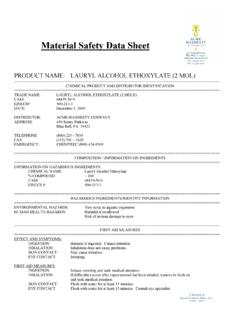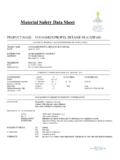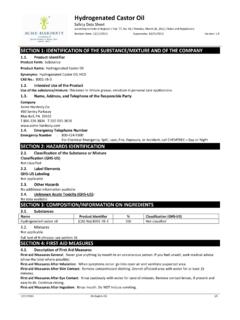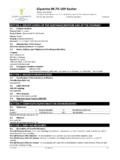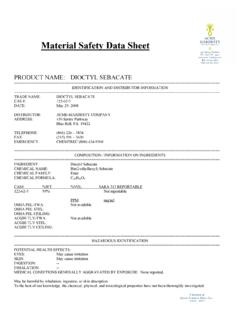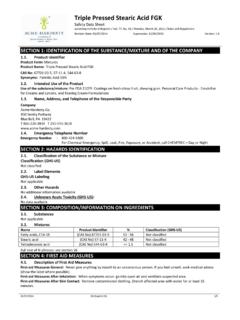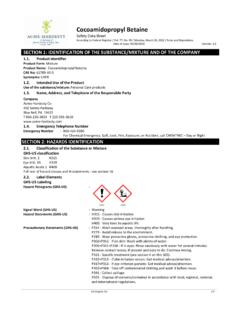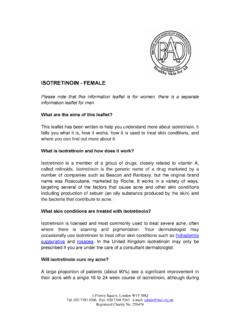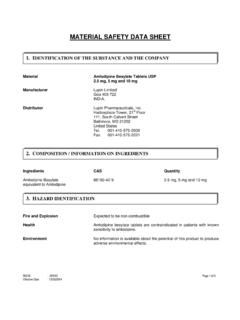Transcription of Material Safety Data Sheet - Acme-Hardesty
1 Material Safety data Sheet PRODUCT NAME: PROPYLENE GLYCOL INDUSTRIAL GRADE ======================================== ======================================== ============= CHEMICAL PRODUCT AND DISTRIBUTOR IDENTIFICATION ======================================== ======================================== ============= TRADE NAME: PROPYLENE GLYCOL INDUSTRIAL GRADE CAS#: 57-55-6 DATE: August 17, 2011 DISTRIBUTOR: Acme-Hardesty COMPANY ADDRESS: 450 Sentry Parkway Blue Bell, PA 19422 TELEPHONE: (866) 226-3834 FAX: (215) 591 3620 EMERGENCY: CHEMTREC (800) 424-9300 ======================================== ======================================== ============= COMPOSITION / INFORMATION ON INGREDIENTS ======================================== ======================================== ============= INGREDIENTS CAS# CONCENTRATION% Monopropylene Glycol 57-55-6 ======================================== ======================================== ============= HAZARDOUS INGREDIENTS/IDENTITY INFORMATION ======================================== ======================================== ============= EMERGENCY OVERVIEW: APPEARANCE AND ODOR: Colorless, Odorless Liquid Safety HAZARDS: Not classified as flammable, but will burn.
2 HEALTH HAZARDS: No specific hazards under normal use conditions. HMIS: Health 2 NFPA: Health 0 Fire: 1 Fire: 1 Reactivity: 0 Reactivity: 0 ======================================== ======================================== ============= FIRST AID MEASURES ======================================== ======================================== ============= INGESTION: In general, no treatment is necessary unless large quantities are swallowed, however, get medical advice. EYE CONTACT: Flush eye with copious quantities of water. If persistent irritation occurs, obtain medical attention. SKIN CONTACT: Remove contaminated clothing. Flush exposed area with water and follow by washing with soap if available. INHALATION: Remove to fresh air.
3 If rapid recovery does not occur, transport to nearest medical facility for additional treatment. NOTE: Treat symptomatically. Following cases of gross overexposure, investigation of liver, kidney and eye function may be advisable. Records of such incidents should be maintained for future reference. Material Safety data Sheet Propylene Glycol Industrial Grade August 17, 2011 Page 2 of 6 ======================================== ======================================== ============= FIRE FIGHTING MEASURES ======================================== ======================================== ============= FLASH POINT: 99 C / 210 F AIR EXPLOSION/FLAMMABILITY LIMITS: - %(V) AUTO IGNITION TEMPERATURE: 421 C / 790 F SPECIFIC HAZARDS: Clear fire area of all non-emergency personnel.
4 Vapor is heavier than air, spreads along the ground and possible distant ignition. Will only burn if enveloped in a pre-existing fire Hazardous combustion products may include: Carbon monoxide. EXTINGUISHING MEDIA: LARGE FIRES: Should only be fought by properly trained fire fighters. Alcohol-resistant foam, water spray or fog SMALL FIRES: Dry chemical powder, carbon dioxide, sand or earth may be used UNSUITABLE EXTINGUISHING MEDIA : Do not use water in a jet. FIREFIGHTER PROTECTIVE EQUIPMENT: Wear full protective clothing and self-contained breathing apparatus. ADDITIONAL ADVICE: All storage areas should be provided with adequate fire-fighting facilities. Keep adjacent containers cool by spraying with water. ======================================== ======================================== ============= ACCIDENTAL RELEASE MEASURES ======================================== ======================================== ============= GENERAL: Observe all relevant local and international regulations.
5 Avoid contact with spilled or released Material . Refer to Personal Protection and Disposal sections. PROTECTIVE MEASURES: Avoid inhaling vapor and/or mists. Avoid contact with the skin. Extinguish any naked flames. Do not smoke. Remove ignition sources. Avoid sparks. Use appropriate containment to avoid environmental contamination. Prevent entering in drains, ditches or rivers by using sand, earth or other appropriate barriers. Ventilate contaminated area thoroughly. CLEAN UP METHODS: LARGE SPILLS (> 1 drum): Transfer by mechanical means (vacuum truck) to salvage tank for recovery/safe disposal. Do not flush away residues with water. Retain as contaminated waste. Allow residues to evaporate or soak up with absorbent Material and dispose of safely.
6 Remove contaminated soil and dispose of safely. SMALL SPILLS (< 1 drum): Transfer by mechanical means to labeled, sealable container for recovery or safe disposal. Allow residues to evaporate or soak up with absorbent Material and dispose of safely. Remove contaminated soil and dispose of safely. ADDITIONAL ADVICE: Proper disposal should be evaluated based on regulatory status of this Material (Disposal Considerations), potential contamination from subsequent use and spillage, and regulations governing disposal in the local area. Observe all relevant local regulations. Material Safety data Sheet Propylene Glycol Industrial Grade August 17, 2011 Page 3 of 6 ======================================== ======================================== ============= HANDLING AND STORAGE ======================================== ======================================== ============= GENERAL: Avoid breathing vapors or contact with Material .
7 Only use in well-ventilated areas Wash thoroughly after handling Refer to Personal Protection section Use the information in this data Sheet as input to a risk assessment of local circumstances to help determine appropriate controls for safe handling, storage and disposal of this Material . HANDLING: Handling Temperature: Ambient. Per good industrial hygiene practices, precautions should be taken to avoid breathing of Material . Use local exhaust extraction over processing area. For lines and fittings, avoid copper, copper alloys, zinc. Avoid contact with skin, eyes, and clothing. Air-dry contaminated clothing in a well-ventilated area before laundering. Extinguish any naked flames. Do not smoke. Remove ignition sources. Avoid sparks. Do not empty into drains.
8 Handling product in drums, Safety footwear should be worn and proper handling equipment used. STORAGE: Storage Temperature: 40 C maximum Prevent all contact with water and with moist atmosphere. TANKS: Must be clean, dry and rust-free. Must be stored in a diked well-ventilated area, away from sunlight, ignition and other sources of heat. Nitrogen blanket recommended for large tanks (capacity 100 m3 or higher). DRUMS: Should be stacked to a maximum of 3 high. Keep container tightly closed. Keep dry. Must be stored in a well-ventilated area, away from sunlight, ignition and other sources of heat. Prevent ingress of water. PRODUCT TRANSFER: Lines should be purged with nitrogen before and after product transfer. Electrostatic charges may be generated during pumping.
9 Electrostatic discharge may cause fire. Keep containers closed when not in use. ADDITIONAL INFORMATION: Ensure that all local regulations regarding handling and storage facilities are followed. Use the information in this data Sheet as input to a risk assessment of local circumstances to help determine appropriate controls for safe handling, storage and disposal of this Material . ======================================== ======================================== ============= STABILITY/REACTIVITY data ======================================== ======================================== ============= STABILITY: Stable. Hygroscopic. CONDITIONS TO AVOID: Heat, flames, and sparks. Temperatures above 40 C MATERIALS TO AVOID: Strong oxidizing agents. Strong acids.
10 HAZARDOUS DECOMPOSITION PRODUCTS: Carbonyl and dioxolane derivatives may be formed Material Safety data Sheet Propylene Glycol Industrial Grade August 17, 2011 Page 4 of 6 ======================================== ======================================== ============= EXPOSURE CONTROLS / PERSONAL PROTECTION ======================================== ======================================== ============= OCCUPATIONAL EXPOSURE LIMITS: None established EXPOSURE CONTROLS: No exposure controls are ordinarily required under normal conditions of use. It is good general industrial hygiene practice to minimize exposure to the Material . PERSONAL PROTECTIVE EQUIP.: Personal protective equipment (PPE) should meet recommended national standards. Check with PPE suppliers.
